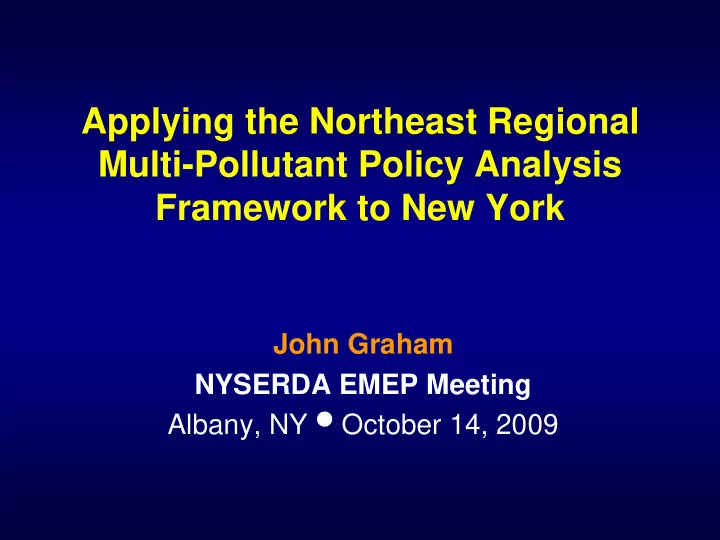

Applying the Northeast Regional Multi-Pollutant Policy Analysis Framework to New York John Graham NYSERDA EMEP Meeting Albany, NY ● October 14, 2009
Acknowledgements NESCAUM NYSDEC • Jason Rudokas • Bob Bielawa • Leah Weiss • Ona Papageorgiou • John Graham • David Gardner • Huiyan Yang • Scott Griffin • Kathleen Fahey • Kevin Civerolo • Gary Kleiman • Carlos Mancilla • Praveen Amar • Kevin Watz • Rob Sliwinski NYSERDA • Sandi Meier • Ted Lawrence • Carl Mas Celebrating 40 Years in Support of Clean Air for the Northeast 2
Presentation Outline • Motivation for proposal and Multi-Pollutant planning in the Northeast • Overview of project: objectives, scope, tasks, and deliverables • Discussion of multi-pollutant framework: its application, advantages and limitations Celebrating 40 Years in Support of Clean Air for the Northeast 3
Motivation for Multi-pollutant Planning Celebrating 40 Years in Support of Clean Air for the Northeast 4
NYSERDA’s Interest: Improved Energy and Environmental Modeling, including Multi-pollutant Control Strategies • Enhance representation of EGUs and associated emissions • Improve links between models • Improve representation of new generation technologies, renewables, energy-efficiency technologies, combined heat & power, and emission control technologies • Model impacts of achieving proposed EE and renewables targets • Model multi-pollutant strategies to evaluate program interactions and ability to meet environmental goals 5
NESCAUM’s Planning Approach • • Traditional Approach NE-MARKAL Energy- Environment model Approach – State-based data collection – (disparate sources, similar Develop regional inventories methods) occurs first, then based on national (DOE), state, combined into regional and local databases; then state- emissions inventories for SIP specific refinement and vetting modeling purposes occurs – “Grown” inventories rely on IPM – Modeled evolution of model (covering power sector technology needed to satisfy only), historical trends, and demand and policy constraints; growth factors these growth assumptions – provided by the model are Difficult to change growth vetted with states and can be assumptions once locked into easily modified to reflect state- IPM and inventories specific conditions – Analyzes one or two projection – Complete evolution over 30 years; results in emissions and year period with costs, air quality changes as metrics technologies, and emissions 6
Project Overview Celebrating 40 Years in Support of Clean Air for the Northeast 7
Project Goals: • To identify a suite of strategies that will simultaneously be able to make significant progress toward ozone, PM, mercury, acid deposition, and climate goals • To use NESCAUM’s Multi -pollutant Policy Analysis Framework (MPAF) to develop a solid basis for these strategies from the perspectives of the economy, technological evolution, the environment, and other public health endpoints Celebrating 40 Years in Support of Clean Air for the Northeast 8
Project Policy Objectives • Build institutional capacity at NYSDEC to use MPAF – Identify policy challenges and capacity building needs, host workshop and document results • Work with NYSDEC to identify & address cross- sector pollutant interactions and trade-offs – Iterative and coordinated process -- strategies must be identified, tailored and refined • Serve as model for replication in broader NE – Assist with NYSERDA on outreach activities: work with PAC/present at EMEP, outreach to EPA, NACAA. OTC, MARAMA, and academic audiences, publish in peer-reviewed literature Celebrating 40 Years in Support of Clean Air for the Northeast 9
Tasks • Identify environmental targets • Identify key strategies • Represent goals and strategies in model, and document reference scenario and assumptions • Employ MPAF • Final Report • Technology Transfer • Public Outreach Celebrating 40 Years in Support of Clean Air for the Northeast 10
Environmental Goals • Climate Change • Attain All NAAQS • Toxics • Reduce critical load exceedences • Improve visibility Celebrating 40 Years in Support of Clean Air for the Northeast 11
Strategies • Renewables (30% by 2015) • Energy Efficiency • Appliance Standards (Energy Star) • Transportation – Increased efficiency in light/heavy duty vehicles – New fuels (ethanol, electricity) • CHP and Industrial Sector Efficiency Celebrating 40 Years in Support of Clean Air for the Northeast 12
NESCAUM’s Multi -Pollutant Policy Analysis Framework (MPAF) 13
NESCAUM’s Multi -Pollutant Policy Analysis Framework Goals & Policies NE-MARKAL Energy Model CMAQ BenMAP Air Quality Model Health Benefits Assessment Evolution of Energy System expenditures Ambient 12-State REMI Concentrations Economic Model Health Effects Wet/Dry Incidence and Deposition Cost/Benefit Key Economic Indicators 14
NE-MARKAL: Energy Model as Centerpiece Today’s Energy System Oil Automobiles Oil Refining Natural Gas Residential Uranium Electricity Generation Commercial Coal Industry Renewables Industry Source: EPA ORD 15
NE-MARKAL: Energy Model as Centerpiece Oil Refining & Processing Automobiles Fossil Fuels Gasification Combustion Residential Biomass H 2 Generation Uranium Nuclear Power Commercial Carbon Sequestration Renewable Resources Clean Energy Industry Source: EPA ORD 16
Advantages to Using NE-MARKAL • Quick and relatively inexpensive to run • Transparent to review • Detailed and versatile framework – Multi-pollutant and Multi-Sector – Analysis of a wide range of climate, air quality and energy strategies • Single or multiple strategy analysis • Single state or entire northeast region • Linked to other models – REMI, CMAQ, BenMAP • Integrated air quality and energy planning 17
NE-MARKAL Caveats • While expansive in its coverage, it does not provide perfect representation of all sectors and technologies • Should be used for comparative policy analysis • Is not an energy dispatch forecast tool 18
THANK YOU! – John Graham • jgraham@nescaum.org (617-259-2023) 19
Recommend
More recommend